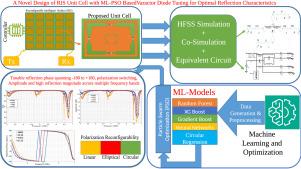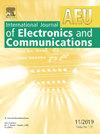A novel design of RIS unit cell with ML-PSO based varactor diode tuning for optimal reflection characteristics
IF 3.2
3区 计算机科学
Q2 ENGINEERING, ELECTRICAL & ELECTRONIC
Aeu-International Journal of Electronics and Communications
Pub Date : 2025-09-25
DOI:10.1016/j.aeue.2025.156048
引用次数: 0
Abstract
This paper introduces a novel reconfigurable intelligent surface (RIS) unit cell capable of frequency-dependent dynamic phase and polarization control. The structure integrates four SMV series varactor diodes, enabling continuous tuning of both phase and axial ratio across multiple frequency bands without requiring physical modification. Full-wave simulations confirm the reconfigurability of the structure across multiple frequency bands. The proposed unit cell demonstrates wideband phase tunability, ranging from to at 3.2 GHz, to at 4.7 GHz, to at 5.0 GHz, to at 5.15 GHz and to at 6.75 GHz. The reflection amplitude remains high (better than –3 dB) across the lower bands (3.2–5.15 GHz), whereas certain states at 6.75 GHz exhibit increased loss, primarily due to tuning asymmetry. At 3.2 and 6.75 GHz, the unit cell demonstrates significant polarization agility, where the axial ratio varies from 1 dB to 65 dB under different biasing conditions, allowing transitions between circular, elliptical, and linear polarization states. Electromagnetic (EM) behavior is validated through co-simulation, and an equivalent circuit model is developed to replicate the varactor-based tuning response. Thereby, a machine learning (ML)-Particle Swarm Optimization (PSO)-based framework is proposed to optimize the reflection characteristics by tuning the input to the varactor diodes. The proposed methodology leverages ML models, including Random Forest, XGBoost, Gradient Boost, Neural Networks, and Circular Regression, to estimate the values of optimal fitness functions. Thereby, the best-performing ML model is utilized to solve a multi-objective optimization problem using PSO, leading to a performance improvement of phase of 16.78%, 8.77%, 7.3%, 3.31% and 1.6% at each frequency respectively. Consequently, the proposed integration of EM simulation, circuit modeling, and data-driven optimization offers a scalable design methodology for RIS, which has been proven with a design of 4 × 3 RIS array and validated with fabrication and testing in an anechoic chamber.

一种基于ML-PSO的变容二极管调谐以获得最佳反射特性的RIS单元电池的新设计
本文介绍了一种新型的可重构智能表面(RIS)单元,该单元具有频率相关的动态相位和极化控制功能。该结构集成了四个SMV系列变容二极管,可以在多个频段连续调谐相位和轴比,而无需进行物理修改。全波仿真证实了该结构在多个频带上的可重构性。所提出的单元电池具有宽带相位可调性,在3.2 GHz时为- 78.66°至134.31°,在4.7 GHz时为- 146.87°至- 177.571°,在5.0 GHz时为- 158.54°至- 192°,在5.15 GHz时为- 163.41°至239.73°,在6.75 GHz时为- 156.99°至+179.9°。在较低的频段(3.2-5.15 GHz),反射振幅仍然很高(优于-3 dB),而在6.75 GHz的某些状态,由于调谐不对称,损耗增加。在3.2 GHz和6.75 GHz频段,单晶片显示出显著的极化敏捷性,在不同偏置条件下,轴向比在1 dB到65 dB之间变化,允许在圆形、椭圆和线性极化状态之间转换。通过联合仿真验证了电磁(EM)行为,并建立了等效电路模型来复制基于变容的调谐响应。因此,提出了一种基于机器学习(ML)-粒子群优化(PSO)的框架,通过调整变容二极管的输入来优化反射特性。提出的方法利用ML模型,包括随机森林、XGBoost、梯度Boost、神经网络和循环回归,来估计最优适应度函数的值。因此,利用性能最好的ML模型,利用粒子群算法求解多目标优化问题,在每个频率下的相位性能提升分别为16.78%、8.77%、7.3%、3.31%和1.6%。因此,EM仿真、电路建模和数据驱动优化的集成为RIS提供了一种可扩展的设计方法,该方法已通过4 × 3 RIS阵列的设计得到验证,并通过暗室的制造和测试得到验证。
本文章由计算机程序翻译,如有差异,请以英文原文为准。
求助全文
约1分钟内获得全文
求助全文
来源期刊
CiteScore
6.90
自引率
18.80%
发文量
292
审稿时长
4.9 months
期刊介绍:
AEÜ is an international scientific journal which publishes both original works and invited tutorials. The journal''s scope covers all aspects of theory and design of circuits, systems and devices for electronics, signal processing, and communication, including:
signal and system theory, digital signal processing
network theory and circuit design
information theory, communication theory and techniques, modulation, source and channel coding
switching theory and techniques, communication protocols
optical communications
microwave theory and techniques, radar, sonar
antennas, wave propagation
AEÜ publishes full papers and letters with very short turn around time but a high standard review process. Review cycles are typically finished within twelve weeks by application of modern electronic communication facilities.

 求助内容:
求助内容: 应助结果提醒方式:
应助结果提醒方式:


